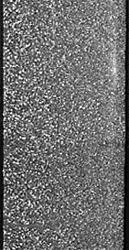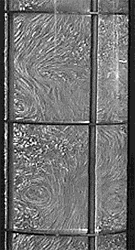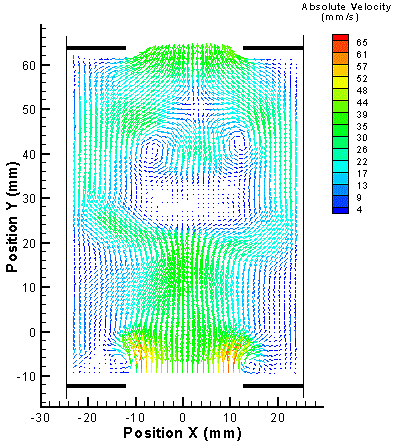Oscillatory Flow Mixing (OFM) occurs when fluid is oscillated between 0.5 and 15 Hz - at an amplitude of typically 1 to 100 mm - in a baffled tube. The oscillating fluid motion interacts with each baffle to form vortices, and the resulting fluid motion gives efficient and uniform mixing in the space between two baffles. The movie in figure 2 shows typical vortex structures occurring in two inter-baffle regions in a baffled tube. Many such well-mixed zones exist along the length of a tube, giving excellent local mixing and global mixing.
 |
 |
| Figure 1 - Oscillatory flow in an unbaffled tube. |
Figure 2 - Oscillatory flow in a baffled tube. |
Mixing charateristics
The dynamic nature of OFM may be characterised by a few fundamental dimensionless groups, namely:
- The classical Reynolds number, Ren = u.ρ.d/μ
- The oscillatory Reynolds number, Reo = w.x0.ρ.d/μ
- The Strouhal number, St = d/4.π.x0
where u is the mean liquid superficial velocity [LT-1], d is the tube internal diameter [L], w is the angular frequency [T-1], x0 is the centre-to-peak amplitude of fluid oscillations [L], ρ is the specific mass of the fluid [ML-3] and μ is the kinematic viscosity of the fluid [M L-1 T-1].
In addition, three dimensionless geometrical parameters contribute to the fluid mechanics in oscillatory baffled reactors:
- The inter-baffle spacing, defined as L/d
- The baffle free-area, a= d0/d
- The baffle thickness, d
where L is the length of the reactor [L], d is the tube internal diameter [L] and d0 is the free baffle diameter [L].
For steady flow in a smooth walled tube, the transition from a laminar Poiseuille flow to a turbulent flow happens at a relatively high Ren (>4000). By altering the internal geometry to include periodically spaced baffles in the tube and superimposing fluid oscillations, the above transition occurs at a relatively low Reynolds number. The oscillating fluid motion interacts with each baffle to form two pairs of vortices in each inter-baffle cavity (Figure 3 below), providing efficient, uniform mixing throughout the length of the reactor.
 |
|
Figure 3 - Experimental flow pattern at an oscillatory Reynolds number, Reo=200, and a Strouhal number, St=1.0, obtained by Particle Imaging Velocimetry (PIV). |

